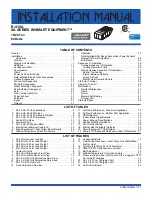
►
1.2.14. When the heater is hot or connected
to the mains electricity or functioning, it
must never be moved, handled, topped-
up or subject to any maintenance
interventions.
►
1.2.15. Do not duct the air entering or
exiting the heater.
►
1.2.16. Keep the hot parts of the heater at
an adequate distance from inflammable
or termolabile materials (including the
power supply cable).
►
1.2.17. If the power supply cable is
damaged, it must be replaced by the
technical after-sales centre, in order to
prevent all risks.
2. UNPACKING
►2.1. Remove all packaging materials used
to wrap and deliver the heater and dispose
of them in compliance with the Standards in
force.
►2.2. Extract all articles from the packaging.
►2.3. Control for any damage undergone
during transport. If the heater appears
damaged, inform the dealer, where the
purchase was made, immediately.
3. ASSEMBLY (29-44 kW)
(SEE FIG. 1)
These models have wheels and handle/s de
-
pending on the model. These components,
complete with relative nuts and bolts, are situ
-
ated in the heater box.
4. FUEL
WARNING: The heater only functions
with DIESEL or KEROSENE.
Only use diesel or kerosene, to prevent the risk
of fire or explosion. Never use petrol, naphtha,
solvents for paints, alcohol or other highly
inflammable fuels.
Use non-toxic anti-freeze additives in the case
of very low temperatures.
5. FUNCTIONING PRINCIPLES
The series of compressor products has a wide
range of power. Models are available with
both single and double combustion flanked
chambers. For heaters with a double combustion
chamber, the two combustion chambers can
be used simultaneously for maximum power,
or a single combustion chamber can be used
for intermediate power.
(SEE FIG. 2)
A. Combustion chamber and heads,
B. Fan,
C. Motor,
D. Compressor,
E. Tank.
The compressor (D) started by the motor
(C) compresses the air, which through the
atomising nozzle, sucks up the fuel from the
tank (E) due to the “VENTURI EFFECT”. On
contact with the igniter, the atomised fuel
ignites inside the combustion chamber (A).
The combustion products are mixed with the
flow of room air generated by the rotation of
the fan (B) and pushed towards the outside of
the heater. A photoresistance, connected to
a circuit board, constantly checks the correct
functioning of the heater, stopping the cycle in
the event of anomalies.
6. FUNCTIONING
WARNING: Thoroughly read the
”INFORMATION REGADRING SAFETY”,
before switching the heater on.
►►6.1. SWITCHING THE HEATER ON:
►6.1.1. Follow all instructions relative to safety.
►6.1.2. Check the presence of fuel in the tank.
►6.1.3. Close the tank cap.
►6.1.4. Connect the power supply plug to
the mains electricity (SEE VOLTAGE IN
“TECHNICAL DATA TABLE”) (SEE FIG. 3).
►6.1.5. Take the “ON/OFF” switch to the
“ON” (|) position (SEE FIG. 4). The heater
should switch-on within a few seconds. If
the heater does not start, consult the “13.
TROUBLESHOOTING” paragraph.
MODELS WITH A DOUBLE COMBUSTION
CHAMBER: To use the heater at maximum
power turn both “ON/OFF” switches to “ON”
(I). To use the heater at intermediate power
turn only one of the “ON/OFF” switches
to “ON” (I). Indications for managing and
selecting ignition of the single chamber are
on the control panel and on the combustion
chamber.
►6.1.6. For the models with room thermostat,
check the position of the knob (SEE FIG.
9-10).
N.B.: IF THE HEATER SHOULD SWITCH-
OFF DUE TO THE LACK OF FUEL, TOP-UP
THE TANK AND RESET THE HEATER (SEE
PAR. 6.2).
en
it
de
es
fr
nl
pt
da
fi
no
sv
pl
ru
cs
hu
sl
tr
hr
lt
lv
et
ro
sk
bg
uk
bs
el
zh






































